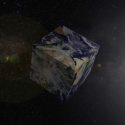You’re running from a volcanic eruption. You fall into a hot lake. The water burns your skin and eyes, and you can hardly breathe. How can a place so dangerous even exist? Located in North Tanzania on the Kenyan border, this red and pink lake is famous for turning animals into stone. Egyptians used sodium carbonate to mummify their dead rulers, and the same chemical preserves animals that die in Lake Natron. Today, we’ll see why you should never trust anything that thrives in Lake Natron.
Number 1. High alkalinity
The high amount of natron, which is sodium carbonate and baking soda, gives this lake its name. It also makes the water highly alkaline. The lake’s water can have a pH as high as 10.5, which is almost as alkaline as ammonia. If it gets in your eyes, this water could make you blind. A good way to protect yourself from highly alkaline water is by wearing a polyethylene suit.
Number 2. Atmospheric ammonia
Even outside the water, you could be in danger. The air around the lake contains ammonia, and breathing it can harm your eyes, throat and lungs. The ammonia in the atmosphere is highest from September to November, so avoid Lake Natron during those months. To survive, get away from the area, remove your clothes and wash your body with soap and water.
Number 3. Cyanobacteria
These blue-green algae are microscopic organisms whose blooms create the red color in the lake. Ingesting or inhaling these toxic blooms can cause diarrhea, vomiting and breathing problems.
If you inhale, ingest or touch the cyanobacteria, its toxins or harmful gasses, take off your contaminated clothing, wash your skin and rinse your eyes with saline fluid.
Number 4. Hot water
Lake Natron’s temperature ranges from 40 °C (104 °F) to 60 °C (140 °F). The hot water can raise your body temperature past 40 °C (104 °F). It’s called hyperthermia and can lead to dizziness, weakness and heat stroke. You’ll need to get out of the water immediately, go to a cooler area and rehydrate. You’d better get out of there fast, or you could pass out and drown.
Number 5. High salt content
The lake contains a high level of sodium chloride or salt. If you drink a lot of salt water, your body will try to maintain its blood pressure by constricting its blood vessels. This might make you feel nauseous, weak and delirious. You’ll need to drink plenty of fresh water to hydrate. If you don’t, your brain and other organs will receive less blood, causing organ failure, coma or even death.
Number 6. Active volcano nearby
The Ol Doinyo Lengai is an active volcano south of Lake Natron. It emits a rare volcanic rock that’s rich in sodium, potassium and calcium carbonate. The volcano has some of the fastest-flowing lava in the world. Wear pants and a shirt with long sleeves when you go to Lake Natron. Also, bring a respirator and goggles. If the volcano erupts, get to high ground and take cover. Avoid pyroclastics like rocks and debris.
Number 7. Flamingos
Pink flamingos rule the lake. Glands in their heads remove salt from the water, and scales protect their legs. They’re not usually dangerous, but flamingos will attack if they feel threatened.
These birds will use their sharp, curved beaks and long claws to scratch you. They’re most likely to be aggressive during the breeding season. If you need to defend yourself, try hitting the legs and knocking the bird off balance. Surviving Lake Natron was a challenge. But believe it or not, this is not the deadliest lake on Earth. Other lakes in Africa connect to underground magma or liquid rock.
Sources
- Ammonia: general information. Editor (2022). Public Health England.
- The Facts About Ammonia. Editor (2022). New York State – Department of Health.
- Lake Natron: Tanzania’s beautiful and deadly red lake. Editor (2022). Follow Alice.
- Facts about Cyanobacterial Blooms for Poison Center Professionals. Editor (2022). Centers for Disease Control and Prevention.
- What Is Hyperthermia and How Is It Treated?. Roland, J. (2020). Healthline.

















